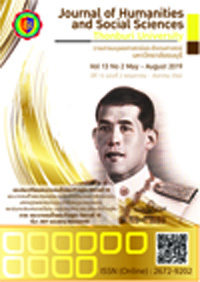FUNCTIONAL ANALYSIS AND OCCUPATIONAL STANDARD FOR VETERINARY ASSISTANT (SMALL ANIMAL)
Keywords:
Functional analysis, Occupational standard, Veterinary assistant, Competency, Vocational EducationAbstract
This research identifies the needs, the first stage, followed by a second stage defining the occupational standard for Veterinary Assistants (Small animal). A descriptive research uses the functional analysis to define the key roles, units of competences, elements of competences and performance criteria. The first stage target group agreed on preparing the occupational standard. The target group comprised 91 persons: the President of the Veterinary Council of Thailand, veterinarian practitioners, government and private veterinary hospitals, management of private veterinary companies, and lecturers at veterinary universities. The research tools are focus groups to gather the ideas and discussions from meetings. The second stage verifies the occupational standard with 102 veterinarians by using questionnaires and analyze data by statistic tools, median and inter quartile.
The result of the research defined the key purpose of the Veterinarian Assistants: assisting the veterinarian practitioners, divided into to three key roles 1) Assist and Work in veterinary practices with standard of and focus on Care & Welfare of Animals consisting of 5 Units of Competences and 17 Elements of Competences, 2) Sanitation and Clinical Care consisting of 3 Units of Competences and 9 Elements of Competences, 3) Front Office Customer Service and Workplace Skills consisting of 4 Units of Competences and 9 Elements of Competences. The target groups all agreed with the set of occupational standards and commented that the result is according to the functions of veterinary assistants.
References
กิตติเชษฐ์ สวัสดิ์ธนากุล วรัทยา ธรรมกิตติภพ และสุนทรา โตบัว. (2558, กันยายน–ธันวาคม). การพัฒนามาตรฐานอาชีพงานเทคโนโลยี สำนักงาน. วารสารครุศาสตร์อุตสาหกรรม. 14(3): 259-266.
รัชต์ ขัตติยะ. (2542). การวิเคราะห์ความต้องการด้านการให้บริการของโรงพยาบาลสัตว์เล็ก คณะสัตวแพทย์ศาสตร์ มหาวิทยาลัยเชียงใหม่. วิทยานิพนธ์ปริญญาโท มหาวิทยาลัยเชียงใหม่.
วรัทยา ธรรมกิตติภพ. (2555). อาชีวศึกษา: ทฤษฎีและการปฏิบัติ. กรุงเทพฯ: บีพีเอ็ม พริ้นท์ เซิร์ฟ.
วารุณี มิลินทปัญญา. (2561). ปัจจัยที่สัมพันธ์กับการคงอยู่ในงานของบุคลากรโรงพยาบาลมหาวิทยาลัย. วารสารวิชาการมหาวิทยาลัยธนบุรี. 12(28): 244-255.
สำนักสถิติพยากรณ์ สำนักงานสถิติแห่งชาติ. (2553). การสำรวจสุนัขที่มีเจ้าของในเขตกรุงเทพมหานคร. กรุงเทพฯ: สำนักงานสถิติแห่งชาติ.
อมร อัศววงสานน์. (2555). หลักสูตรฝึกอบรมผู้ช่วยสัตวแพทย์ในทัศนะของผู้เชี่ยวชาญ. วารสารครุศาสตร์อุตสาหกรรม มหาวิทยาลัยเทคโนโลยีราชมงคลธัญบุรี. 1(2): 53-59.
Deissinger, T. and Hellwig, S. (2011). Structures and functions of Competency-based Education and Training (CBET): A comparative perspective. Germany, Deutsche Gesellschaft für International Zusammenarbeit (GIZ) GmbH.
Fletcher. (1991). NVQs, Standards and Competence. London, UK: Kogan Page.
Geoff and Boutall, T. (2011). Guide to Developing National Occupational Standards. UK Commission for Employment and Skills. Retrieved from https://www.gov.uk/government/uploads/ system/uploads/attachment_data/file/304239/nos-guide-for-developers-2011.pdf
Lester and Religa, J. (2016). ‘Competence’ and occupational standards: observations from six European countries. ComProCom: Communicating Professional Competence. Retrieved from http://devmts.org.uk/parn2017.pdf
Rösch et. al., L. (2013). Through competence-based to employment-oriented education and training: A guide for TVET practitioners. Germany: Deutsche Gesellschaft fur International Zusammenarbeit (GIZ) GmbH.
Translated Thai References
Aungsawawongsanon, A. (2012). Veterinary nursing training course in expert’s opinion. Journal of Technical Education Rajamangala University of Technology Thanyaburi, 1(2): 53-59. (in Thai)
Department of Livestock Development, Ministry of Agriculture and Cooperatives. 2015. The expansion of the pet business. Retrieved from http://www.dld.go.th (in Thai)
Khattiya, R. (1999). Needs Analysis in the services of the Small Animal Hospital in the Veterinary Faculty, Chiang Mai University. (Unpublished Master Thesis). Chiang Mai University, Chiang Mai. (in Thai)
Milinthapunya, Warunee. (2018). Factors Related to Retention of Employees at a University Hospital. Journal of Thonburi University. 12(28): 244-255. (in Thai)
Sawatthanasakul, K. Thammakittipob, V., and Tobua, S. (2015). Development of Occupation Standard for Office Technology. Journal of Industrial Education, 14(3): 259-266. (in Thai)
Statistical Forecasting National Statistical Office. (2010). A survey of dog owners in Bangkok. Bangkok, Thailand: National Statistical Office. (in Thai)
Thammakittipob, V. (2012). Vocational Education: Theory and Practice. Bangkok, Thailand: BPM Print Serve. (in Thai)







